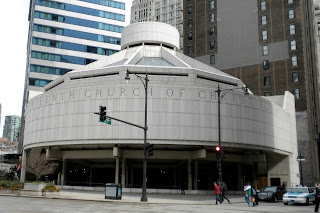Back in October, when Justin and I participated in Open House Chicago and got to go behind the scenes at a number of downtown buildings, I decided to hold off on blogging about the churches we saw in order to give them their proper due as part of my "Religious Experience" series. Given how busy I've been the last couple months, I never made it over to the Harold Washington Library to do further research on them, and I never got around to writing about them. Since the end of the year is going out with a bit of a whimper around here (the cold I'm coming down with is going to keep me from fitting in much else this week), and I had to go to the library today to check out some books for work anyway, I decided to pick up another copy of the ever-helpful Chicago Churches and Synagogues: An Architectural Pilgrimage by George Lane while I was there.
I fell off the wagon a bit with my church visiting schedule this year, and only made it to a total of three in all of 2011. I haven't given up on my project, but clearly it's going to be more of an ongoing endeavor than I had originally envisioned. Keep a lookout for my write-up on the other church we visited back in October, which I'm going to hold in reserve for the undoubtedly busy days that lie ahead while we're moving in January. In the meantime, here's the story behind the Loop's quirky Christian Scientist church:
Seventeenth Church of Christ, Scientist
55 East Wacker Drive
Chicago, Illinois
Oddly enough, the unusual Seventeenth Church of Christ, Scientist figures prominently in my early memories of Chicago. Whenever we would come into the city for dentist appointments, shopping, or lunches with my dad, Mom would always take the Ohio Street exit, and eventually drive past the Christian Scientist church on our way to wherever we were going. It always caught my eye, even as a child, because it was so distinctly different than all the skyscrapers surrounding it. At about three stories tall, it's one of the shortest buildings in the dense construction of downtown. As I got older, I became amazed that the church hadn't sold their doubtlessly valuable land to build a high-rise, and was impressed that they held their ground.
Frankly, I've always found the church rather unattractive (modern architecture has never been my favorite), but in researching it, I discovered that it was designed in 1968 by Harry Weese & Associates, the same architecture firm that created the Metropolitan Correctional Center of Chicago in 1975. That building, while innovative for its use of bar-less, five-inch wide windows, is also somewhat of an eyesore in my opinion, and the fact that both buildings were designed by the same firm says a lot.
The Church, with its concrete construction and similarly nearly windowless design, was intended to insulate the sanctuary from the prevalent street noise surrounding its busy downtown location. Music and testimonials delivered by members of the congregation form the nexus of the Christian Scientist service, so it was important for them to block out as much outside noise as possible. The unusual layout of the building's interior, partially necessitated by the odd seven-sided lot on which the building is situated, is designed so that no seat is too far away from the central lectern, creating a sense of intimacy.
 |
| I don't really know much about Christian Science, but I kind of like this quote from its founder, despite the fact that I'm pretty sure it has to do with things like medicine not being necessary. |
The only natural light in the building comes from a small skylight located in the oculus of the ceiling and a ring of small, narrow windows surrounding it. This stands as a stark contrast to traditional ecclesiastic architecture from Gothic times onward, which emphasized stained glass windows and the introduction of as much sunlight as possible to emphasize the connection between the church and notions of heaven. It was interesting to see how modern architectural concepts as well as site-specific constraints combined to create a different sort of space for worship in this church. That said, I think this is actually one of the least attractive churches I've ever seen, and by far, the least visually appealing one I've visited in conjunction with my Chicago church-going project.


No comments:
Post a Comment